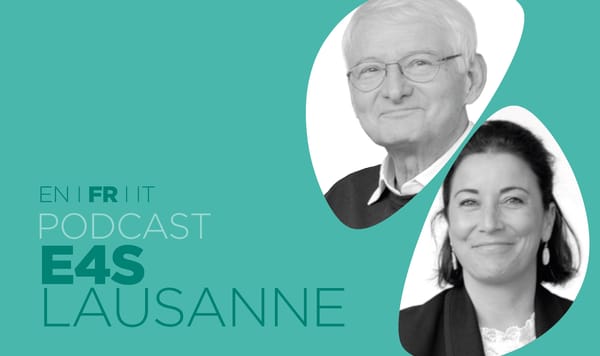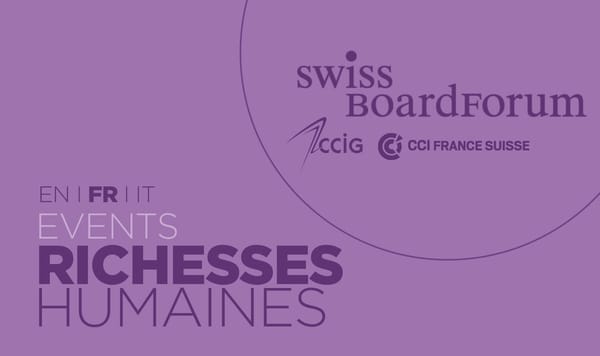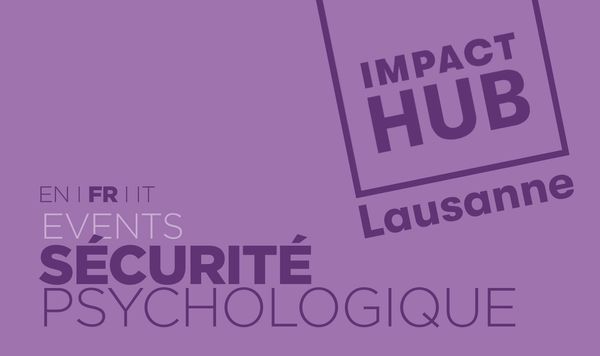OPEN YOUR EYES AS I DID, IT’S JUST ABOUT MINDSET... MY PERSONAL JOURNEY
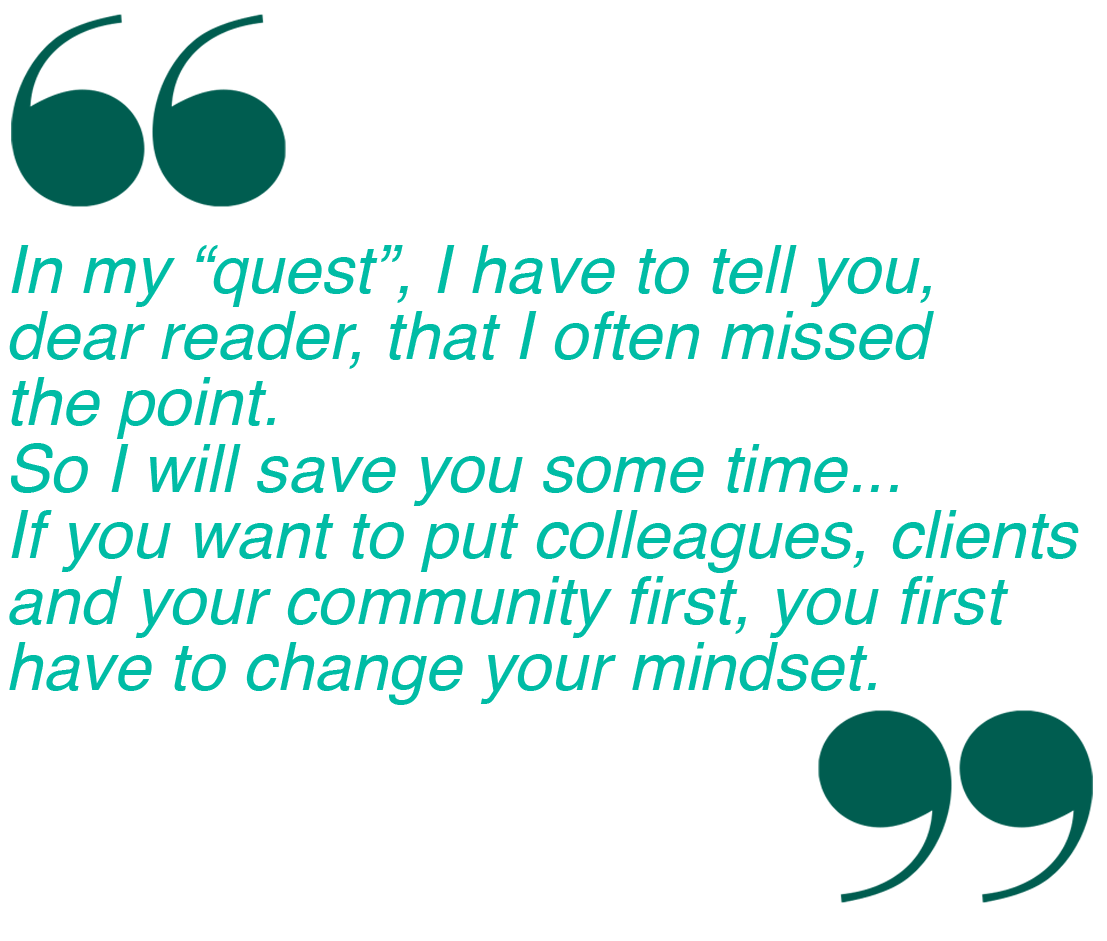
Have you ever noticed that the vast majority of people don’t know exactly what they want in their life but are very quick to list everything they don’t want? I respect that with a lot of kindness. But this is a big issue for their own good and for our common good.
I believe that everyone is an unstoppable force of good and holds a potential to be unveiled. But for some reason, sometimes, there is no space to express it and therefore there is no feeling of fulfillment, no pride and no great outcome. Most of my friends feel stuck in the middle of something when they are not close to burn-out or brown-out. I should confess that my personal track is not made only of joyful and purposeful moments. But I have never lost hope to create a better professional and humane workplace. Even when I was considered as an idealist or even a dangerous game-changer. I cannot just imagine the role of a manager or of an HR expert as a mechanic who considers colleagues as an inert and replaceable piece of inhumane and bureaucratic machinery.
I wake up every morning looking for someone to inspire, to make them aware that they have more to give, that they can actively and positively change the world around them. I wake up every morning with the hope to be surprised and inspired in return.
This internal and powerful motivation has gradually led me to co-found KINDNESSforBusiness to respond to an unstoppable need to go the extra mile and to participate in the major game shift that mankind will face during this century. In this article, I want to share my personal narrative about how I became a trustful, engaged and successful change-maker and, at the same time, why I couldn't be fulfilled without a commitment toward advocacy about Kindness (and how it can be a vitamin and a lubricant for our businesses). I sincerely and deeply believe we can really change and improve our professional workplace. I have organized this very personal testimony in 5 parts: the trigger, the search, the rock-bottom, the turning point & finally the big win.
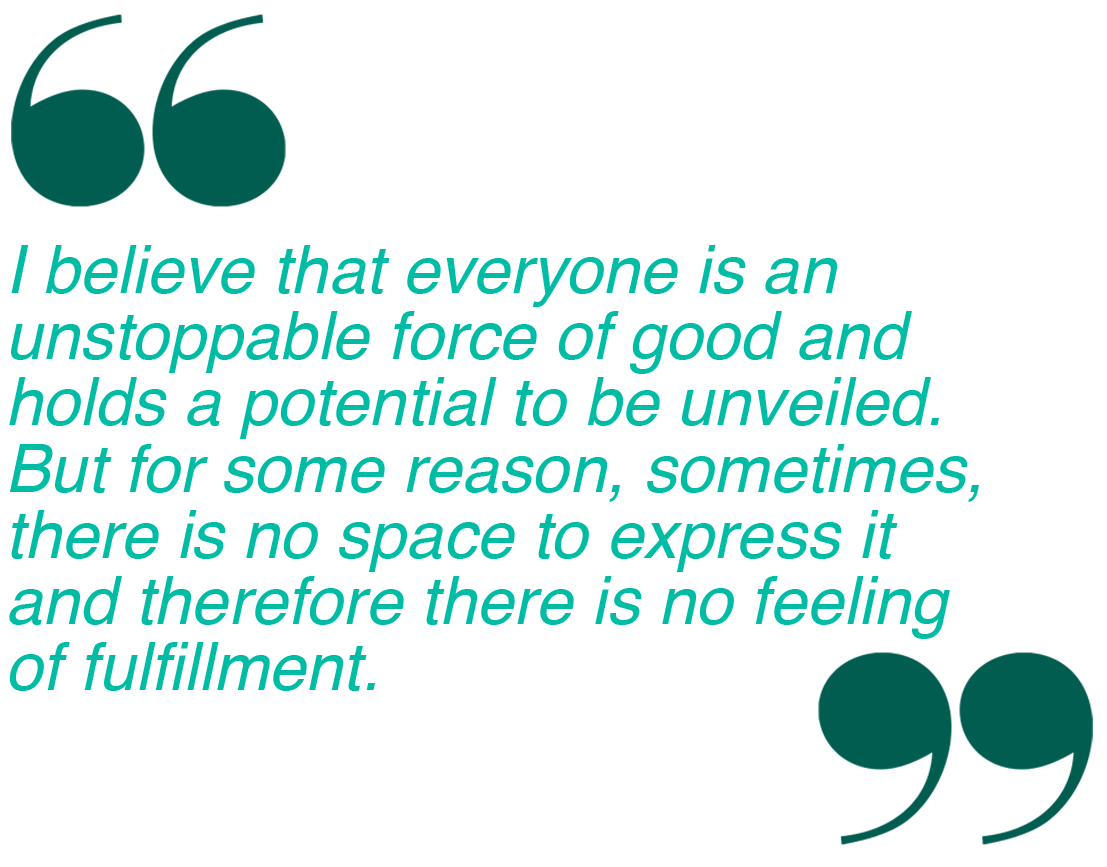
1. The Trigger: a battle between “up or out” and “in your potential we trust”
Like anyone else who graduated from a French business school, I wanted to participate in the development of great businesses and success stories. The main issue is that within the courses I followed and, within the major corporations I joined later, the value of people taking part in these results used to be widely underestimated. It seamed we have forgotten that companies are institutions that succeed thanks to their people, thanks to the women and men who are inside them and thanks to their potential and their desire to have a purposeful life. This potential holds a lot of intelligence that is helpful to face the uncertainty of our times and to be more resilient, more agile, and, in the end, more profitable. It is huge but mainly untapped when people only want to make available and make a difference. But in some way, our practices discourage them to do so and many of us will remain some kind of sleeping beauties.
Since the very beginning of my carrier, I was lucky enough to accompany H&M's entry into the French market, and to early discover the Swedish management style, which was very different and appealing to me. How was it different exactly? Of course, I am not an expert on the Nordic management culture but as far as I saw it many times, it simply entrusts talents. I saw undergraduate and unexperimented people getting huge responsibilities after a simple talk with the Swedish CEO where they demonstrated trust in themselves, passion, and commitment that desperately need to be leveraged for a collective purpose. This was also a demanding process since they didn’t accept easily that targets were not reached. But they invest in you and help you getting started by giving you training, mentoring, and so on, thus maximizing your chances to succeed. I was not prepared for what I saw at H&M. It challenged me and everything I believed to know.
Just to finish this little story of my beginning as a “lost in translation” professional, I should add that at that time I had a lot of friends a little younger than me or a little less educated, who told me about their difficulty in finding a job and once found about their frustration. What shocked me the most was to witness the disappointment of another friend of mine. While he has succeeded to get a great position at the company he had always dreamed of, he decided after just one year to invest himself in a stamp collecting club (no offense to any kind of collectors) because he could not express himself at all at work. He even renounced to adapt or to rebel, he just stopped engaging and turned his brain off. This had become my obsession: on one hand, we have an enormous human potential that is largely under-exploited and, on the other hand, there is a kind of fatality. Why do our colleagues not manage to realize themselves, even though they invest themselves intensely in their professional activity? Why, when I talk to friends, do I hear more frustration than pleasure?
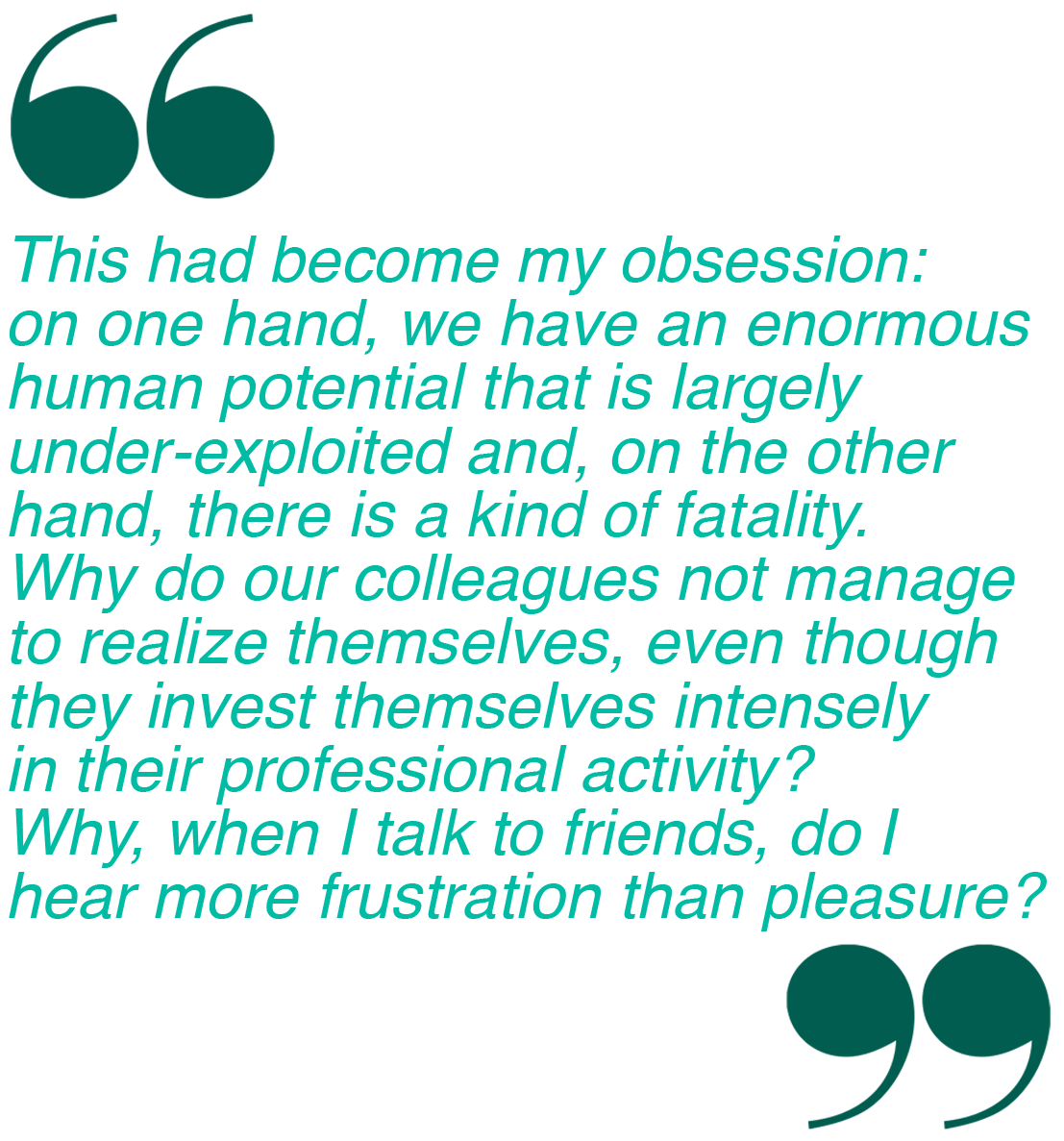
2. The Search: my quest toward a better or at least more human professional world
My career path has led me to work for large organizations as well as for start-ups, for companies with a strong culture and operating in ambiguous, political, complex and international contexts. I can see that no matter the environment and the rhetoric, the human being is and remains in the background. 15 years ago CSR was very fashionable, 10 years ago the trend was about caring for people and enlightenment for the employees and about customer experience for the clients. But did we change really the place of humans in our company? Are they at the center? If some progress has been made, and no doubt it has, we shall also admit that the revolution mainly failed and that the vast majority of the companies only have enriched the annual report of enthusiastic statements, nice narratives but in the same time confidence toward big companies has dropped, engagement has nosedived and a lot of relatively new diseases have been recognized as professional ones. What is blocking, what is jammed? A lack of method, dashboards that do not focus attention, a lack of sincerity from the leaders? Yes probably. But there is more. In my search to understand why the system is unable to adapt to what we now all call the VUCA[1] context, I have to confess that I missed the essential point and I have lost 10 years. I was stupidly looking for new methods and proof of concept when it was much simpler (but also complex) than that.
After being a consultant specialized in CSR, as explained above, I became a manager. I became the director of a business unit, I was the sales director, I had more than 200 salespeople under my responsibility. It's normal to talk about sales performance, I fully subscribe to it, but we were in an era of a massive shift toward online sales and we had to cope with a radical transformation of the profession. I proposed to each store to emancipate itself as an autonomous entity with the support of management. I encouraged them to create partnerships with other stores present in their shopping malls and to organize events. I wanted to demonstrate that, since the salesmen are not simple ticket issuers on demand, they can make customers want to travel like travel advisors. Although my approach brought obvious results, it remained largely misunderstood. Firstly, salespeople thought that I pushed too far to demonstrate their value to the management when remote top managers only seemed to be planning for their demise. They were wait-and-see oriented, which was understandable since they had lost trust in the system and were used to changing managers every three years. Secondly, the managers were quite destabilized by this encouragement towards an openly given trust: they had always been used to micromanagement methods and been told over and over again that "trust does not exclude control". And finally, the two executives to whom I was directly reporting were looking at me as an idealist with a revolutionary streak. Not being able to convince them was my failure. I was not able to understand why good performance is not enough to demonstrate the importance of putting the human factor at the center. It's also true that other sales managers had had just as good results with their more traditional and less revolutionary methods. I understood that, even if companies always talk about KPI, they tend to use them only to confirm pre-established beliefs. The dashboards are definitely not powered only by rationality but by a belief-driven rationale.
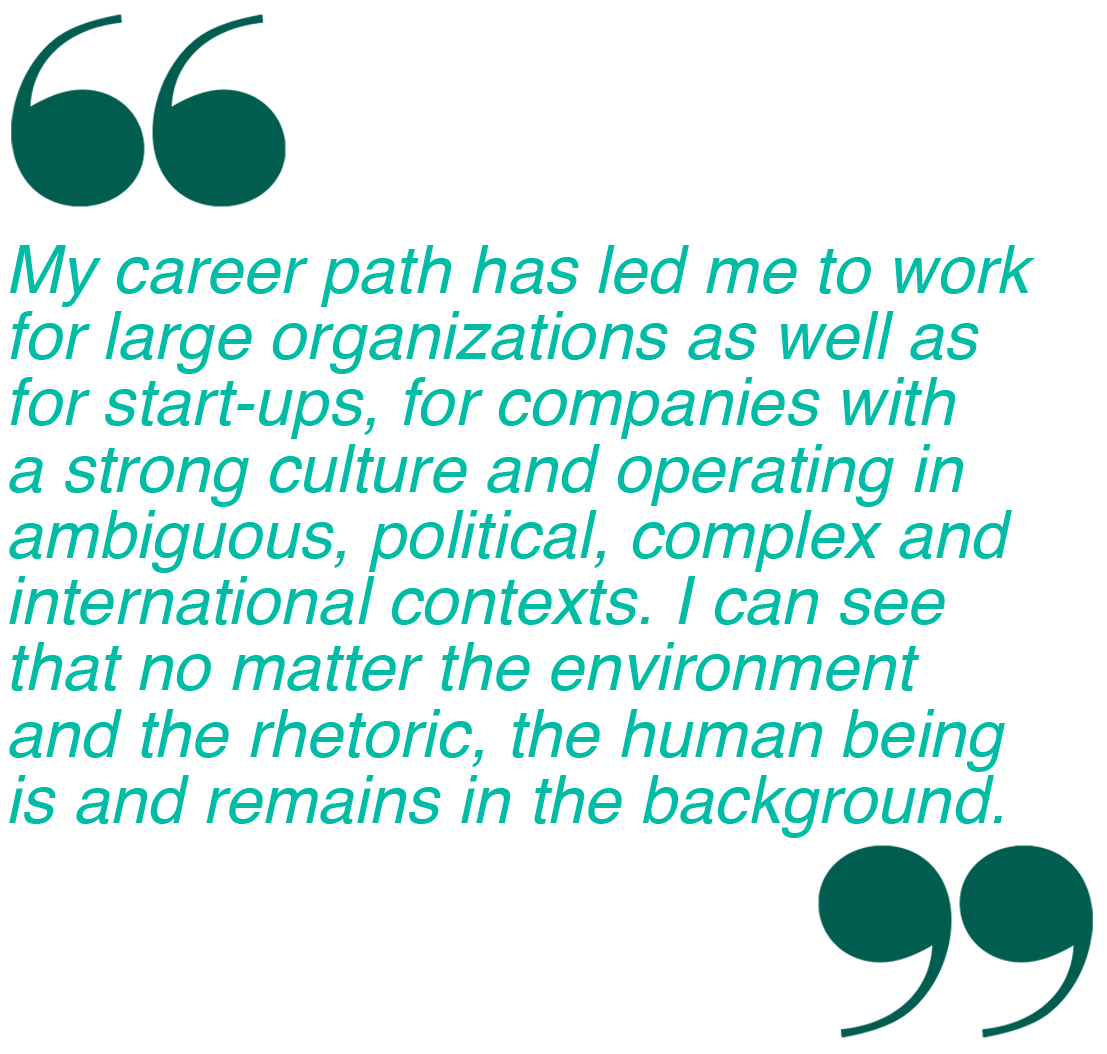
In the following years, supported by the digital mindset andby the widely spread idea that we must "care" for our client and our people, my speech became to be a little more audible. I was still on a very experimental way of doing things, but I had been able to convince my CEO to create a department in charge of both the customer and the employee experience and I succeeded to include some of our suppliers in our program. I was one of the four adventurers who, with a visionary boss, gave birth to OuiBus, the new European long-distance coach service. We certainly wanted to sell a very affordable service but we also refused the logic of "you'll get your money's worth, so you'll be transported like in a tin can". I have made trips all over Europe to benchmark our competitors, sometimes accompanied by sociologists and designers. We all agreed: customers and staff alike had too much of a degrading, stressful experience to be satisfied with the service and the company they have chosen. It was also very clear that the whole experience was bound to the boarding phase. This benchmarking and market research led me to the strong belief that we should start with a game-changing strategy. And quickly the whole team began to share the vision of a revolution for the long-distance customer experience. But I was also convinced that the best ideas quite rarely come from an office. I asked My General Manager to authorize the recruitment of two coach drivers (one man and one woman) 8 months ahead of schedule. Together with these two enthusiastic drivers and my passionate team, we did some real-life tests by renting a coach and asking our colleagues to enter a role play. Transformed into travelers, according to the scenario we decided them to play, they had to challenge our ideas and processes. My colleague Paul, former general manager of a very large English carrier “kindly” laughed at our idea of introducing "super boarding". It seemed too expensive, too complex to roll out, and too long to design. I was still perceived as an idealist and my team was exposed to this judgement but we had shared a strong vision and our commitment gave us a little extra patience. But a few months later, the results were there, we had really repositioned the market standard, the customers were more satisfied than on the TGV (high-speed train, i.e. the top-notch service of SNCF) and above all our staff was very proud.
With that experience, I had understood the virtuous circle of vision, reliability, pride, and collective intelligence that led a business to be more innovative and the strategy execution to be more shared and fluid. I was starting to realize on the field how big was the true potential of a larger and vivid staff empowerment when done up to the "front raw" and when supported by a sincere trust. I would like to introduce another concept here. Empowerment is about increasing the autonomy of decision-making of subordinates and their capacity for initiative. Emancipation is about going one step further and making them feel fully legitimate (and not just been granted) to do, experiment, and even fail. It is about making them learn by doing and helping them to fulfill their quest for meaning and to realize themselves. Emancipation is definitely an upskilled empowerment.
Only a few years later, “the freedom inc” (a book published in France in 2017) [2] had a strong impact in France. It strongly conveyed what Gary Hammel had prophetized 10 years before, i.e. the end of the management we knew [3]. The French media started to speak of “liberation” (sometimes probably with the intent to use also a possible misconception with the release from a prison). Even if I started to realize that the problem was the beliefs more than the methods, I was locked in the only mindset I knew and whose principle was told many times (too many to be counted). I was a sort of prisoner of my beliefs and I didn't even know that an alternative already existed, which had been available, even if infrequent, since the 60s.
3. The Rock-Bottom: in front of an unsurpassed wall, a major shift is needed
At this time, I had the opportunity to work for the Italian subsidiary of SNCF that operates the TGV between Paris and Milan. We were in 2014. In 2015 the Universal Exhibition was planned in Milan, therefore the city that had previously been shunned by foreign tourists in favour of Florence, Rome, Naples and other even more exquisite beauties, was going to become a lasting tourist destination. And above all, we anticipated our trains to be full!
But both good news and victories are bound to end, and eventually they reveal how vulnerable we are. At the beginning of 2016, that’s exactly what happened. For three main reasons:
1. The market had been radically transformed by low-cost airlines, so long-distance railways were much less relevant. The rail marginal cost of production increases when its optimum is reached, while the marginal cost of low-cost air travel decreases continuously. Milan had become a relevant operational base for Easyjet, which had obtained an entire terminal at the international airport and slots at the city center airport. They offered reduced travel time, lower prices and above all a range of different and more convenient schedules. And let me also underline that we had up to 6 low-cost airlines competing with us. We were deemed to be swept off the market.
2. At the same time, we were facing a serious social crisis. We were losing all our train drivers and other operatives and executives in our safety department in a 15 months-battle for our survival. Being vulnerable is an understatement, but we were also quite literally bloodless.
3. Finally, regulations were changed and we had to invest massively to renovate our trains or buy new ones.
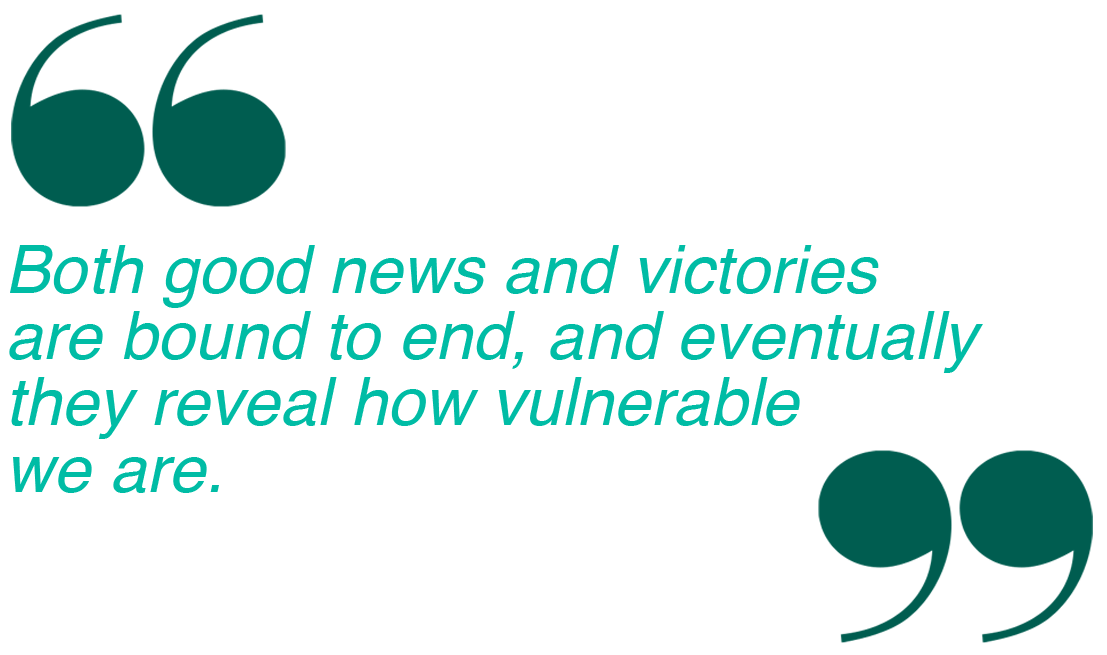
How could we expect, in this impossible market, with this social crisis, and with these new regulation conditions, that our group would invest in us? As HR Director, I asked myself if I should get ready to lay off everyone and turn off the lights. My conviction, based on my expertise in People Experience and long distance services, was that as long as we would continue to sell only a means of transportation and not a journey enriched with day-to-day experience, we would remain a dying branch. But to provide a unique experience, to make a kind of cruise train that could be renowned worldwide, we would need crews that would be more committed than ever. The issue was precisely that our staff was leaving and those who stayed with us were discouraged and disengaged. Fear is obviously a powerful engine, but it has a bunch of particularly negative collateral effects (sometimes with a delayed effect). Even if we couldn't totally eliminate this feeling (that is also a lever), we desperately needed a common, exciting, even crazy vision. Beyond saving the company, what I wanted to do was also to succeed in demonstrating that our colleagues were great people. But at this time, it would have been enough to offer them a little bit of morale and achieve that they no longer wake up in the morning with a tremendous desire to stay at home.
4. The Turning Point: let everything emerge and flows!
My General Manager, Jérôme, was also convinced. We needed a vision, we needed to create it together with the staff and above all, we needed to let them do what they knew to be the better or let say the most suitable. We couldn’t start without the agreement of the board of directors and for that, we would have to reassure many people far beyond this first circle. We decided to execute a roadshow and meet the group's top managers. The reactions were contrasted: they ranged from a polite smile up to sympathetic listening and sometimes even a frank enthusiasm. The deal was more or less implicit: if things would go wrong, the two of us would have taken the blame. This deal suited me (and I think it was the same for Jérôme), provided we would be allowed to go through with it. And that was the case.
We had a strong belief: for this type of transformation (or some would say organizational development) there is no roadmap, no battle plan, we would have to let things emerge, but we had to start with something. Sending a clear signal about our new culture was necessary, then the team will co-design everything. Jerome told a very inspiring story in which we were innovative, collaborative, human-centric. He explained that in order to succeed we would have to rely on each other’s trust, commit to a distributed decisional process (based on parity), and accept (and celebrate) the right to make mistakes. The first milestones were also about projects: every employee was free to carry out a project (or a cause). The only go-no-go process was driven by the way he or she would succeed in engaging colleagues and members of management. From the very beginning, we discussed with the board of directors of possibility (and opportunity) to let employees be real project leaders granted to see c-levels and be legitimate in doing so. The biggest project led by a train manager was a 7 figure budget. Another project, less technical and driven as a special event, created a buzz that gave us the largest (free) media coverage we had ever had.
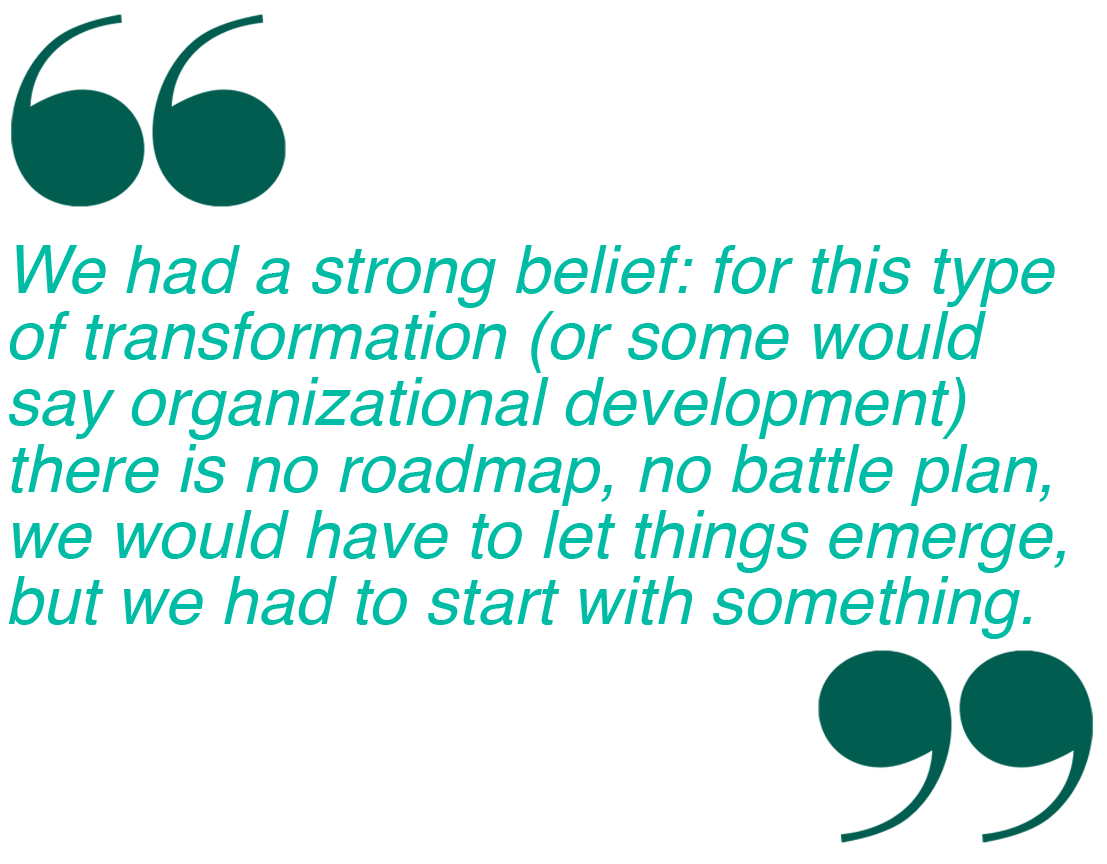
I am personally convinced that the commitment of these courageous pioneers made our shareholders wanting to support us. They helped us to go the extra mile and we were greenlighted with several dozens of millions of euros investment that were necessary to bring our trains up to standards and to offer us a future that we had lost and that we no longer dared to dream about. The new culture has been enforced by example and over time. A large, non-hierarchical team of "transformation leaders" was set up. We trained our friends and colleagues from Decathlon and Kiabi who received us in their DAT[3] seminars and we challenged ourselves with new experiences such as working with horses to develop leadership capabilities (which gave us a beautiful opportunity: a report on the 3rd main Italian TV channel). The skeptics became more or less convinced but we lacked the coherence brought by a specific organization and some practices (especially decision-making practices), which could totally reflect our new culture.
This was where sociocracy came in. I met Marc Mathys who told me "you are blocked because you have liberated the structures but not structured the freedoms". At the same time, we received the results of our Great Place to Work survey and they confirmed what we already knew: the results were clearly above average (very encouraging compared to the past) but not enough to get the label. What handicapped us the most was the leadership which was not yet satisfactory. therefore, we decided to get trained into sociocracy. For weeks in our transformational group and in our executive committee, we tried practices like the decision by consent and looked for a more organic and purpose drive organization.
5. The BIG WIN: as long as it is not coherent enough, keep on looking forward to a new balance and don’t forget to make your colleagues proud.
It took place on January 30, 2020. That very evening, we were leaving a two-day company seminar during which, despite some reluctance, all the company's employees and those of the SNCF subsidiaries who work for us decided to give us a final proof of trust (and also of self-confidence, I should say). For two days we improved and refined the initial proposal we prepared with the aim to elaborate a complete reorganization and operating charter. We were pretty surprised and moved because everyone (every single attending colleague) agreed to take this leap into the unknown. Our organization would no longer resemble an organizational chart, and we would also succeed to swipe off the well-known and rigidifying silos structure. From this very moment, we operated with circles of autonomous teams structured around transversal topics representing the vision we wanted to achieve. For me, after 4 years, the transformation was almost over, so I could and I felt I had to hand it over since the teams were now totally autonomous. They just needed protection and encouragement.
But that was not the only gift that life gave me that day. That evening we presented our documentary. Three years of transformation, including joy, pride and without hindering doubts, fears, or frustrations. Our teams were the protagonists of this movie made by a film director accompanied by a team of sociologists. In the room, there were train drivers, train managers, managers and representatives of support functions, but also, executives, business owners, consultants and university professors. When the lights went back on, there were a lot of applause, and the eyes became misty. My colleagues were proud. The audience was quite unanimous in recognizing the courage of the teams and the fact that, if it is possible at SNCF, it is possible everywhere. This was an important point: SNCF as a railway company is a pretty easy workplace to understand for everyone as public service, as an enormous bureaucracy, as a rigidified environment due to political stakes, to the vast number of regulations, to the compliance to many internal rules.
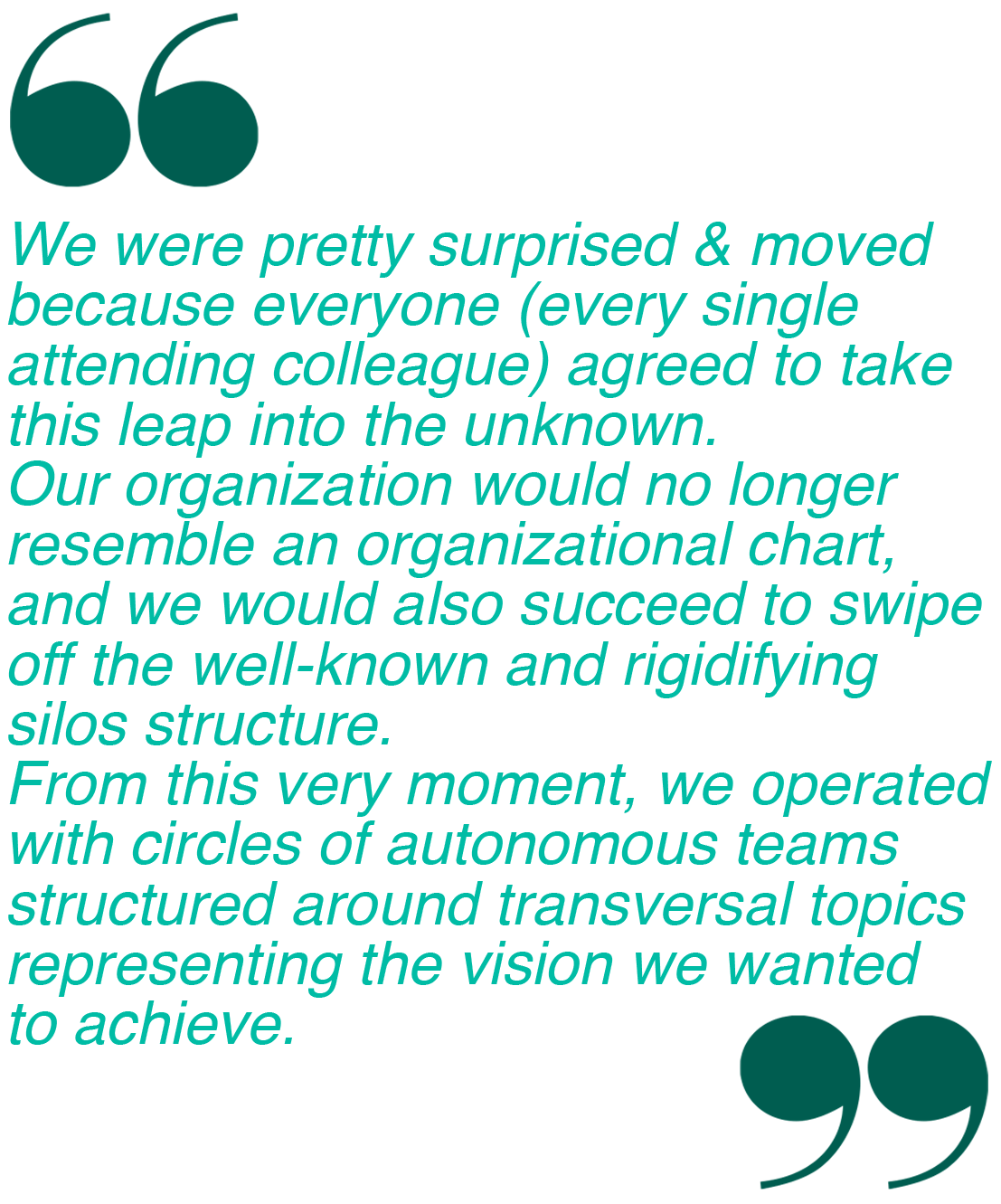
That evening I understood that it was my turn to make this alternative mindset shine and to finally assume what I am: a facilitator at the service of the enormous, untapped (and sometimes wasted), individual and collective human potential. At SNCF we had demonstrated that it is possible and that it is profitable, efficient, impacting and rejuvenating. That very evening, with my external partners Sophie (who had been helping me for months), Francesco (who has inspired me and given me so much from the beginning), Olivier (who has always supported me), Alexandra (and her horses who made us understand what kind leadership really is), Pietro, Mariacristina, Paolo and so many others... the seed was planted. It would take a few more months and not everyone would participate in the project, but KINDNESSforBusiness as an initiative was born during this catalyzing event, from our feeling of necessity and strength, because we had something to say and to share, based not on convictions but on evidence.
Conclusion: this is not about methods, this is about mindset
In my “quest”, I have to tell you, dear reader, that I often missed the point. So I will save you some time... If you want to put colleagues, clients and your community first, you first have to change your mindset.
Stop thinking that:
- your organization is a piece of machinery compounded by wheels and mechanisms. By doing so you are compelled to looking for optimization and to see humans as a resource. Every human being is a talent and all of our institutions are connected and interdependent. So you need to start in a very organic and systemic way to accept that things will emerge when needed.
- You cannot trust humans (according to the belief of homo oeconomicus who only seeks to optimize his global retribution in relation to his involvement), and that you should control everyone and create compliance rules for every management issue. Give your trust freely, control only when it is not honored, let talent thrive by supporting them, open every doors and windows.
- basically, business is a zero-sum game since it leads you toward a "splitting the pie" mentality [5]. Together we can create what didn’t exist before, this is the so-called generative abundance we advocate for at KINDNESSforBusiness.

Gratitude
The list of people I owe this personal transformation is very long. I won’t be able to list them all here but I would like to thank some of them: Bruno Godineau, Bertrand Gosselin, Maria Harti, Jérôme Fontaine, Danielle Papagallo, Paolo Rossi, Pietro Tacconi, Alexandra Rieger, Mariacristina Terrenghi and Elisa Donnini. Some of them are also co-founders of KINDNESSforBusiness. A special thought to Sophie Her, Olivier Raymond, Alain Fayolle and Francesco Mondora.
- VUCA stands for Volatility, Uncertainty, Complexity and Ambiguity.
- Freedom, INC.: Free Your Employees and Let Them Lead Your Business to Higher Productivity, Profits, and Growth, Brian M Carney & Isaac Getz, ed. Argo-Novis (2016).
- The Future of Management, Gary Hamel, ed. Harvard Business Review Press (2007). I would also promote another excellent book of him: Humanocracy, Creating Organizations as Amazing as the People Inside Them (same editor, 2020).
- DAT stands for "becoming actors of transformation".
- See the article published by Alex Edmans, economist of the London Business School who is advocating for a stakeholders capitalism.

